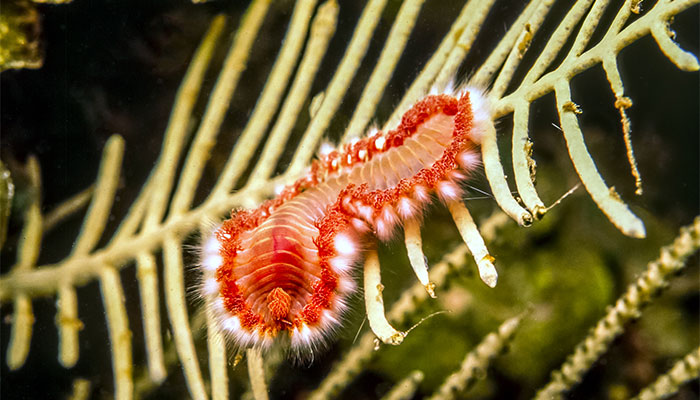Young solitary lizards watch and learn from their elders
Researchers have found that the Eastern Water Skink, despite its solitary lifestyle, can be added to the growing list of animals capable of social learning. Furthermore, they can be added to an even shorter list of animals in which social learning has been shown to be age-dependent.
“It is intuitive that social learning is a short-cut to solving many of life’s problems and allows individuals to acquire information more quickly,” says Macquarie University’s Associate Professor Martin Whiting.
“Just think back to when you got your first video recorder all those years ago, or satellite TV, with a remote with more functions than a space shuttle. Who wants to spend hours poring over an instructional manual when a teenager can give you a quick tutorial and have you watching and recording your favourite programs in a matter of minutes.”
Social learning was traditionally thought to be the domain of animals with so called executive intelligence, such as primates and birds. For example, chimps or crows can learn to use tools by watching group members in action. More recently, social learning has been documented in a much wider range of species including insects, turtles, fishes and tadpoles.
“This should not be all together surprising, because natural selection should select for animals capable of rapidly acquiring essential information that will ultimately give them the edge over rivals,” said Whiting.
Daniel Noble and Martin Whiting from Macquarie’s Department of Biological Sciences teamed up with Richard Byrne from the University of St. Andrews in Scotland to conduct the first test of social learning in a lizard.
They used two groups of Eastern Water Skink (Eulamprus quoyii) that varied in age: ‘old’ lizards were approximately five years of age while ‘young’ lizards were 1.5 to two years old.
They began by training a group of demonstrators to solve the task of flipping a lid off a dish in order to acquire a mealworm food reward. They then randomly allocated lizards either to a social learning treatment, where they would see the demonstrator solve a task, or to a control, where they would see another lizard but without the task. The lizards were separated from each other by a piece of Perspex. Both young and old lizards were put through two different tasks that differed in complexity.
A male Eastern Water Skink makes an incorrect first choice
The results showed old lizards did not use social information in any significant way, and learnt to solve the tasks at much the same speed as the control group. Young lizards on the other hand, did pay attention to social information and learnt to solve the second task faster than both the control group, and old lizards.
“There may be several reasons for this interesting result,” said Whiting.
“Young lizards may stand to benefit more than older lizards by paying attention to the life lessons of older lizards. Alternatively, they may also have more opportunity for social learning because adults are less tolerant of rivals, and more likely to chase adults away than they would a juvenile.”
Age-dependent social learning in a lizard, Biology Letters 2014, Daniel W. A. Noble, Richard W. Byrne and Martin J. Whiting, http://dx.doi.org/10.1098/rsbl.2014.0430
Researchers have found that the Eastern Water Skink, despite its solitary lifestyle, can be added to the growing list of animals capable of social learning. Furthermore, they can be added to an even shorter list of animals in which social learning has been shown to be age-dependent.
“It is intuitive that social learning is a short-cut to solving many of life’s problems and allows individuals to acquire information more quickly,” says Macquarie University’s Associate Professor Martin Whiting.
“Just think back to when you got your first video recorder all those years ago, or satellite TV, with a remote with more functions than a space shuttle. Who wants to spend hours poring over an instructional manual when a teenager can give you a quick tutorial and have you watching and recording your favourite programs in a matter of minutes.”
Social learning was traditionally thought to be the domain of animals with so called executive intelligence, such as primates and birds. For example, chimps or crows can learn to use tools by watching group members in action. More recently, social learning has been documented in a much wider range of species including insects, turtles, fishes and tadpoles.
“This should not be all together surprising, because natural selection should select for animals capable of rapidly acquiring essential information that will ultimately give them the edge over rivals,” said Whiting.
Daniel Noble and Martin Whiting from Macquarie’s Department of Biological Sciences teamed up with Richard Byrne from the University of St. Andrews in Scotland to conduct the first test of social learning in a lizard.
They used two groups of Eastern Water Skink (Eulamprus quoyii) that varied in age: ‘old’ lizards were approximately five years of age while ‘young’ lizards were 1.5 to two years old.
They began by training a group of demonstrators to solve the task of flipping a lid off a dish in order to acquire a mealworm food reward. They then randomly allocated lizards either to a social learning treatment, where they would see the demonstrator solve a task, or to a control, where they would see another lizard but without the task. The lizards were separated from each other by a piece of Perspex. Both young and old lizards were put through two different tasks that differed in complexity.
A male Eastern Water Skink makes an incorrect first choice
The results showed old lizards did not use social information in any significant way, and learnt to solve the tasks at much the same speed as the control group. Young lizards on the other hand, did pay attention to social information and learnt to solve the second task faster than both the control group, and old lizards.
“There may be several reasons for this interesting result,” said Whiting.
“Young lizards may stand to benefit more than older lizards by paying attention to the life lessons of older lizards. Alternatively, they may also have more opportunity for social learning because adults are less tolerant of rivals, and more likely to chase adults away than they would a juvenile.”
Age-dependent social learning in a lizard, Biology Letters 2014, Daniel W. A. Noble, Richard W. Byrne and Martin J. Whiting, http://dx.doi.org/10.1098/rsbl.2014.0430



